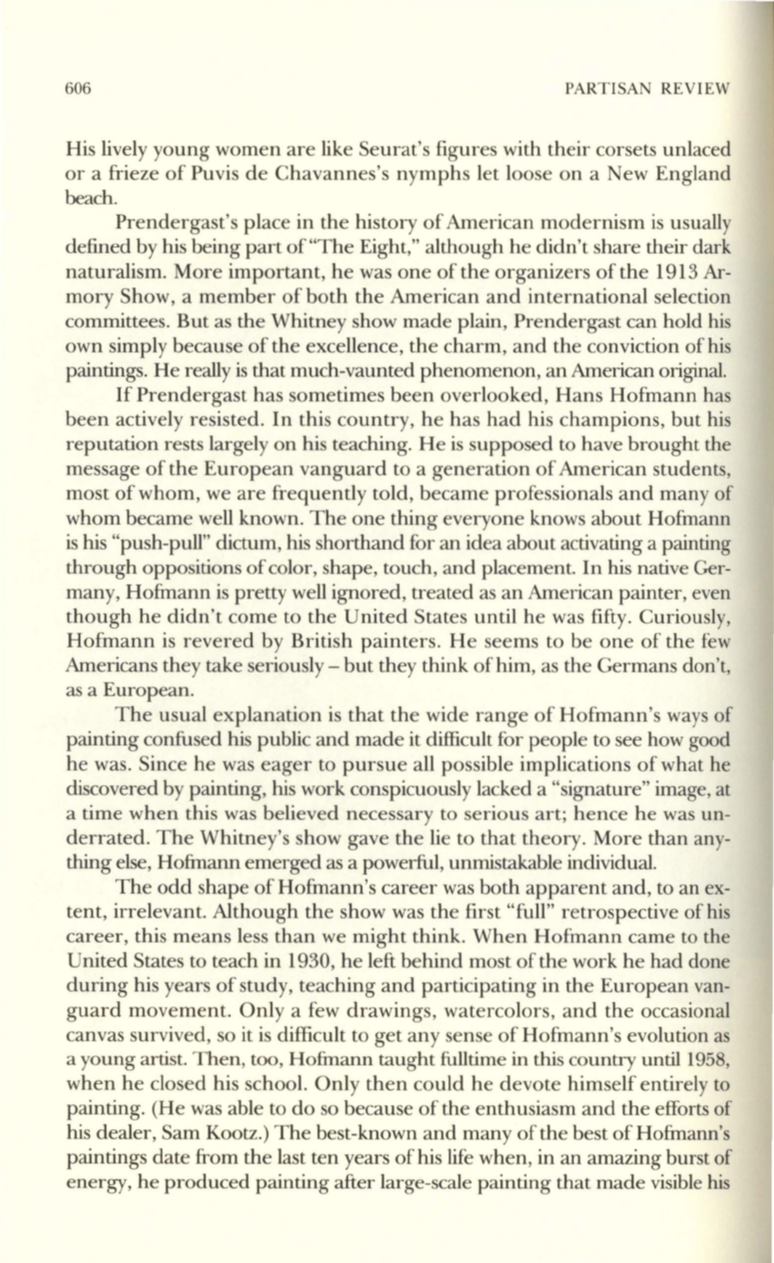
606
PARTISAN REVIEW
His lively young women are like Seurat's figures with their corsets unlaced
or a frieze of Puvis de Chavannes's nymphs let loose on a ew England
beach.
Prendergast's place in the history ofAmerican modernism is usually
defined by his being part of "The Eight," although he didn't share their dark
naturalism. More important, he was one of the organizers of the 1913
Ar–
mory Show, a member of both the American and international selection
committees. But as the Whitney show made plain, Prendergast can hold his
own simply because of the excellence, the charm, and the conviction of his
paintings. He really is that much-vaunted phenomenon, an American original.
If Prendergast has sometimes been overlooked, Hans Hofmann has
been actively resisted. In this country, he has had his champions, but his
reputation rests largely on his teaching. He is supposed to have brought the
message of the European vanguard to a generation ofAmerican students,
most of whom, we are frequently told, became professionals and many of
whom became well known. The one thing everyone knows about Hofmann
is
his "push-pull" dictum, his shorthand for an idea about activating a painting
through oppositions of color, shape, touch, and placement. In his native Ger–
many, Hofmann is pretty well ignored, treated as an American painter, even
though he didn't come
to
the United States until he was fifty. Curiously,
Hofmann is revered by British painters. He seems to be one of the few
Americans they take seriously - but they think of him, as the Germans don't,
as a European.
The usual explanation is that the wide range of Hofmann's ways of
painting confused his public and made it difficult for people to see how good
he was. Since he was eager to pursue all possible implications of what he
discovered by painting, his work conspicuously lacked a "signature" image, at
a time when this was believed necessary to serious art; hence he was un–
derrated. The Whitney's show gave the lie to that theory. More than any–
thing else, Hofmann emerged as a powerful, unmistakable individual.
The odd shape of Hofmann's career was both apparent and, to an ex–
tent, irrelevant. Although the show was the first "full" retrospective of his
career, this means less than we might think. When Hofmann came to the
United States to teach in 1930, he left behind most of the work he had done
during his years of study, teaching and participating in the European van–
guard movement. Only a few drawings, watercolors, and the occasional
canvas survived, so it is difficult to get any sense of Hofmann's evolution as
a young artist. Then, too, Hofmann taught fulltime in this country until 1958,
when he closed his school. Only then could he devote himself entirely to
painting. (He was able to do so because of the enthusiasm and the efforts of
his dealer, Sam Kootz.) The best-known and many of the best of Hofmann's
paintings date from the last ten years of his life when, in an amazing burst of
energy, he produced painting after large-scale painting that made visible his


